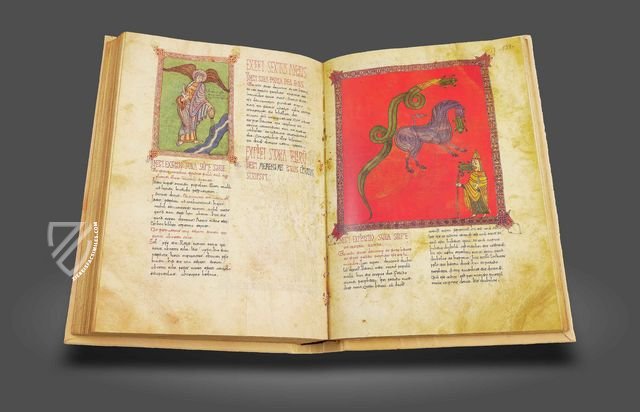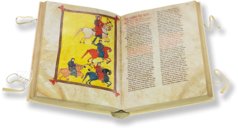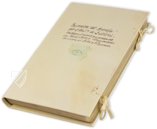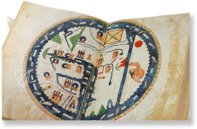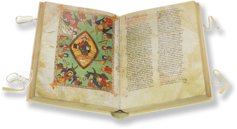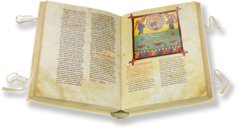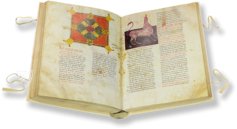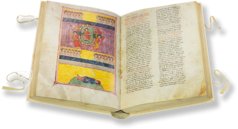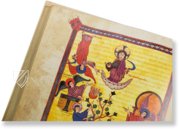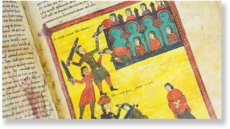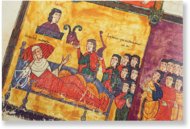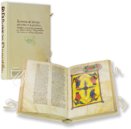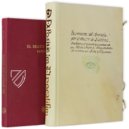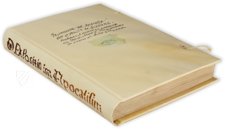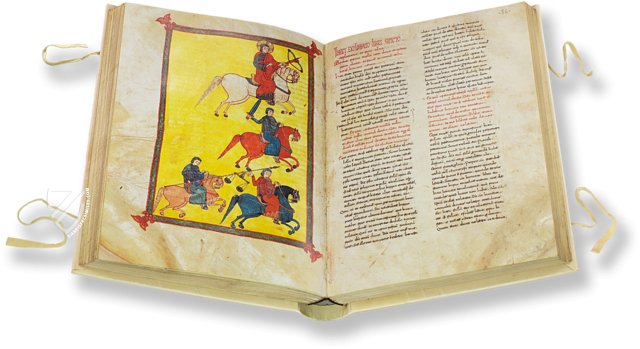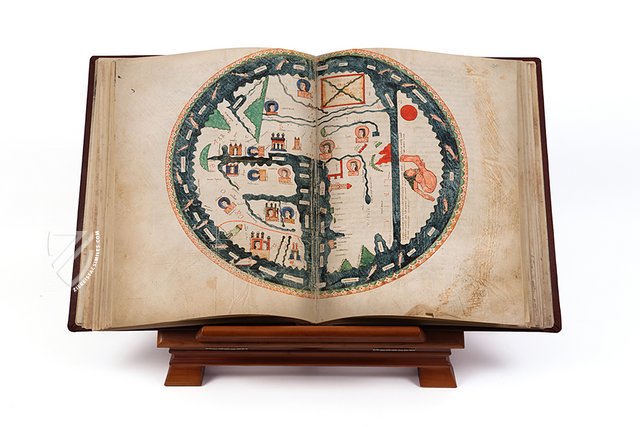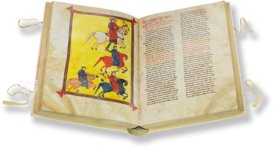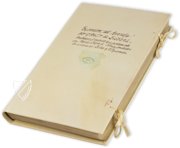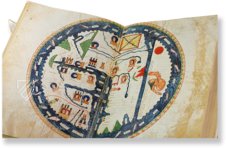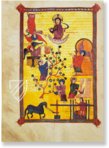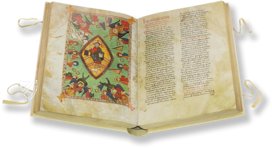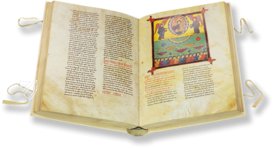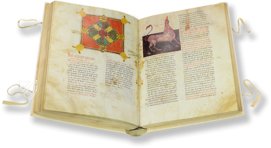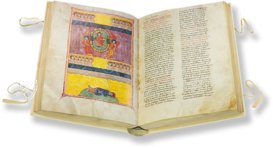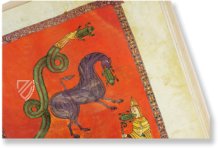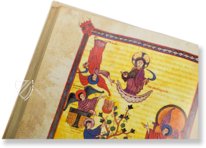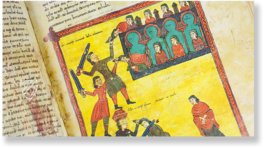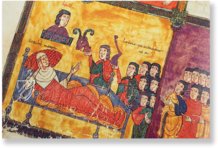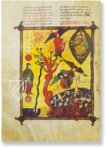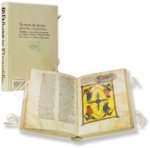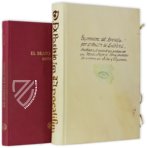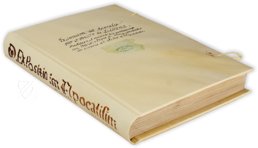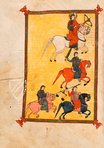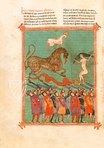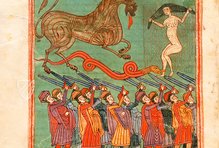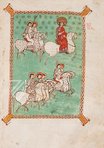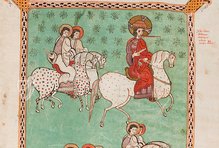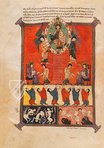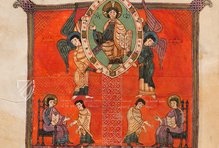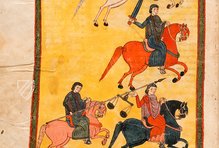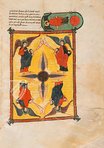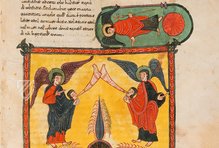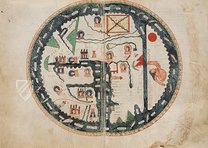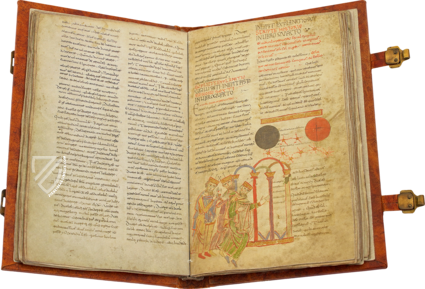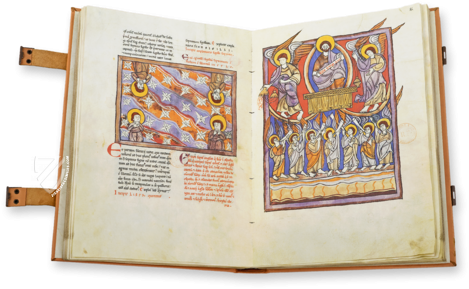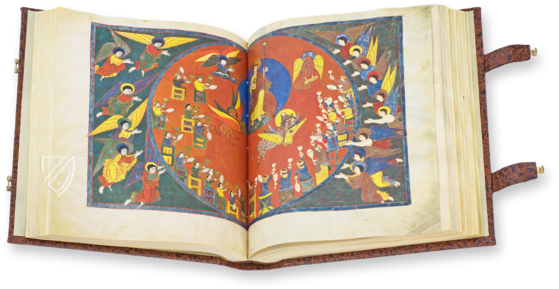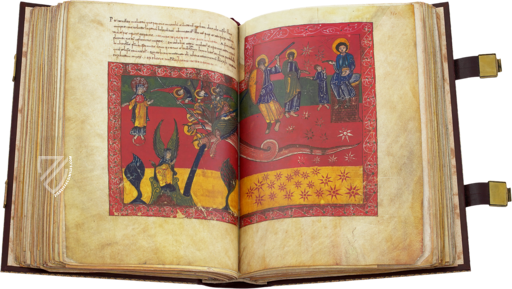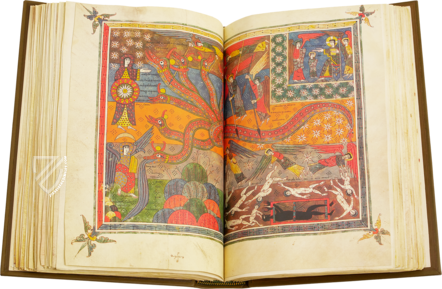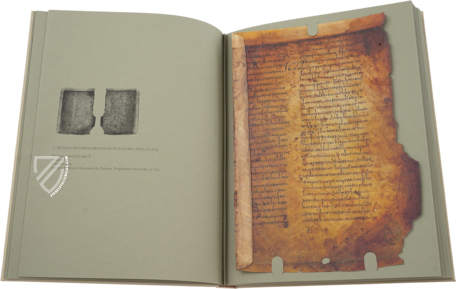Beatus of Liébana - Burgo de Osma Codex
(3,000€ - 7,000€)
The most famous Apocalypse commentary of the entire Middle Ages in a splendid and exceptionally high-quality manuscript: the so-called Beatus of Burgo de Osma is stored in the significant collection of the northern Spanish Cathedral of Burgo de Osma. This large-format codex presents the famous Apocalypse Commentary of Beatus of Liébana on 332 pages with a total of 71 miniatures. Originating in the year 1086 in the influential scriptorium of Sahagún, the Spanish manuscript impressively represents the transition from the Mozarabic to the Romanesque style. In luminously bright miniatures, magnificent figures present the apocalyptic events. Fantastical, sometimes gruesome, sometimes impressive creatures illustrate the Book of Revelation along with the accompanying commentary by Beatus of Liébana.
Beatus of Liébana - Burgo de Osma Codex
The most famous Apocalypse commentary of the entire Middle Ages in a splendid and exceptionally high-quality manuscript: the so-called Beatus of Burgo de Osma is stored in the significant collection of the northern Spanish Cathedral of Burgo de Osma. This large-format codex presents the famous Apocalypse Commentary of Beatus of Liébana on 332 pages with a total of 71 miniatures. Originating in the year 1086 in the influential scriptorium of Sahagún, the Spanish manuscript impressively represents the transition from the Mozarabic to the Romanesque style. In luminously bright miniatures, magnificent figures present the apocalyptic events. Fantastical, sometimes gruesome, sometimes impressive creatures illustrate the Book of Revelation along with the accompanying commentary by Beatus of Liébana.
The Biblical Tale of the Apocalypse
Apocalyptic riders on strong steeds, a naked woman beside a huge snake, colorful hosts armed with swords, and the enthroned Christ borne by two angels: all these images unite the Book of Revelation, the so-called Apocalypse. The Asturian monk and theologian Beatus of Liébana (ca. 730–800), composed an influential and significant commentary in 776 to the Book of Revelation. Divided into 12 books, Beatus of Liébana collected clarifying commentaries to the allegorical and symbolic images of the Book of Revelation in his magnum opus. In doing so he referenced sources from various older authors, which he condensed into set pieces. This most-famous Apocalypse commentary of the entire Middle Ages was recorded in splendid and exceptionally high-quality, for the most part wonderfully illuminated manuscripts. The famous Beatus manuscripts predominantly originated from the north of Spain from the 10th to the 12th centuries. 30 surviving Beatus manuscripts, of which 27 are richly furnished with magnificent miniatures, attest to this popularity and high quality.
Outstanding Romanesque-Mozarabic Miniatures
The so-called Beatus of Burgo de Osma stands at the threshold between the Mozarabic and Romanesque styles. It represents thereby a unique feature. The broad color palette of the magnificent miniatures is still starkly characterized by the Mozarabic, yet the figures in their physicality are already Romanesque. On 71 pages of miniatures, the Beatus of Burgo de Osma presents splendidly colored scenes before a monochrome background. The miniaturist, whose name Martinus is known, designed the picture pages in an extremely decorative fashion, e.g. with the idea in mind to invest the miniatures as geometrically and symmetrically as possible. The miniatures were surrounded by gorgeous frames, which appear simple, but are nonetheless adorned at the corners with ornamental elements of braids. These elements are strongly reminiscent of Celtic ornamentation and insular illumination.
The Apostles as Missionaries of the World
Famous above all is the mappa mundi of the Codex Burgo de Osma, the magnificent world map on a double page. The Earth is presented circularly engulfed by water. The map shows the continents with the 12 Apostles, who were sent by Jesus to missionary work in various regions of the world. Mythical creatures – e.g. a fantastical person with only one leg, called a sciapod by the Greeks – populate the so-called terra incognita. In research, the famous mappa mundi of the Codex Burgo de Osma has been compared with the world map of the Beatus of Saint-Sever.
Famous Place of Origin and Storage
This Beautus codex originated from Burgo de Osma in the year 1086. According to an inscription, the manuscript was begun on either the 3rd of January or 3rd of June of that year. Sahagún is presumed to be the place of origin. The scriptorium of this Cluniac monastery in the bishopric of Leon was cutting-edge in Spanish illumination. Today the manuscript is stored in the library of the Cathedral of Burgos de Osma. This Castilian episcopal city in the north of Spain is famous to this day for its gorgeous medieval old town. At the beginning of the 12th century, Saint Pedro de Osma acted as bishop, whose exceptional tomb can be inspected in the cathedral. San Pedro de Osma was also the one who ordered the construction of a cathedral in Burgo de Osma. The Gothic cathedral in Burgo de Osma houses a significant collection of codices, the famous Beatus of Burgo de Osma first and foremost among them.
Codicology
- Alternative Titles
- Beatus von Liébana - Codex Burgo de Osma
Beato de Liébana del Burgo de Osma
Apocalypsis: El Beato de Osma
El Beato de El Burgo de Osma. Apocalipsis de San Juan - Size / Format
- 332 pages / 36.1 × 25.3 cm
- Origin
- Spain
- Date
- 1086
- Epochs
- Style
- Genre
- Language
- Illustrations
- 71 pages with illuminations
- Artist / School
- Beatus of Liébana (died after 798) (author)
Petrus (scribe)
Martinus (illuminator)
Beatus of Liébana - Burgo de Osma Codex
The Woman and the Dragon
The Woman of the Apocalypse is one of the most prominent figures of John’s Revelation and is widely considered to be either the Virgin Mary or God’s people as a whole. She is shown with the moon at her feet, the sun at her back, and crowned with twelve stars as the red, seven-headed dragon who wants to devour her child approaches. This event provokes the War in Heaven, whereby the child is saved and the Archangel Michael smites the Dragon, casting it down from heaven.
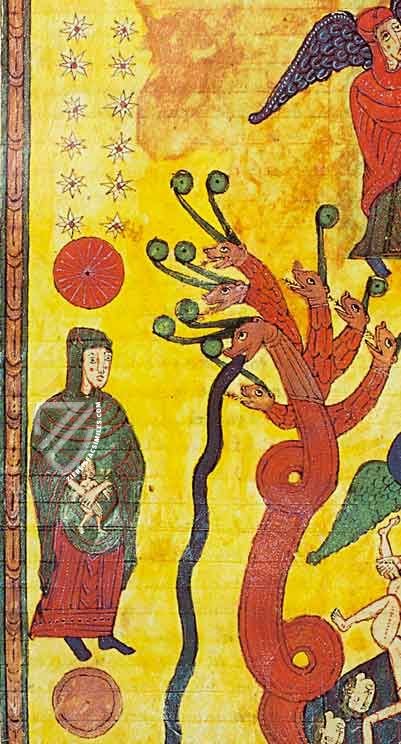
Beatus of Liébana - Burgo de Osma Codex
Mappa Mundi
One of the special features of this Beatus manuscript is the fact that it contains a double-page Mappa Mundi. Along with the specimen from the Saint-Sever Codex, it is one of the finest of these Quadripartite or Beatus Maps, which were intended to be more spiritual and symbolic – being East-oriented with Jerusalem at the center – than geographically accurate.
The Earth is artfully presented in a circle surrounded by water with Asia at the top, Europe and “Libya” (Africa) at the bottom, and the mythical continent, the so-called terra incognita or “Antipodes” separate and to the right, which is peopled by the one-legged monopods. The 12 Apostles can be found missionizing across the world, which has a simple but elegant design.
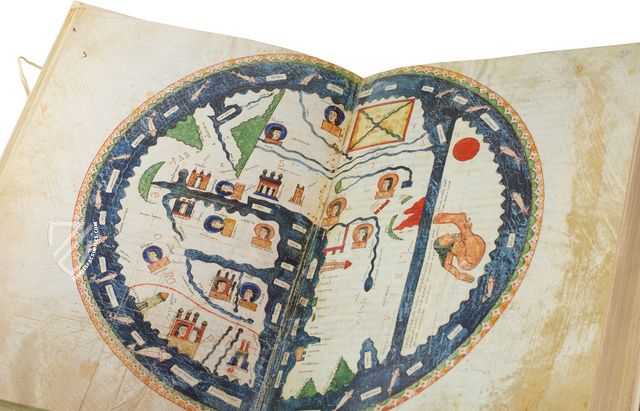
#1 Beato de Liébana del Burgo de Osma
Languages: English, Spanish
(3,000€ - 7,000€)
#2 Apocolípsis: El Beato del Burgo de Osma
Language: Spanish
(over 10,000€)
- Treatises / Secular Books
- Apocalypses / Beatus
- Astronomy / Astrology
- Bestiaries
- Bibles / Gospels
- Chronicles / History / Law
- Geography / Maps
- Saints' Lives
- Islam / Oriental
- Judaism / Hebrew
- Single Leaf Collections
- Leonardo da Vinci
- Literature / Poetry
- Liturgical Manuscripts
- Medicine / Botany / Alchemy
- Music
- Mythology / Prophecies
- Psalters
- Other Religious Books
- Games / Hunting
- Private Devotion Books
- Other Genres
- Afghanistan
- Armenia
- Austria
- Belgium
- Belize
- Bosnia and Herzegovina
- China
- Colombia
- Costa Rica
- Croatia
- Cyprus
- Czech Republic
- Denmark
- Egypt
- El Salvador
- Ethiopia
- France
- Germany
- Greece
- Guatemala
- Honduras
- Hungary
- India
- Iran
- Iraq
- Israel
- Italy
- Japan
- Jordan
- Kazakhstan
- Kyrgyzstan
- Lebanon
- Liechtenstein
- Luxembourg
- Mexico
- Morocco
- Netherlands
- Palestine
- Panama
- Peru
- Poland
- Portugal
- Romania
- Russia
- Serbia
- Spain
- Sri Lanka
- Sweden
- Switzerland
- Syria
- Tajikistan
- Turkey
- Turkmenistan
- Ukraine
- United Kingdom
- United States
- Uzbekistan
- Vatican City
- A. Oosthoek, van Holkema & Warendorf
- Aboca Museum
- Ajuntament de Valencia
- Akademie Verlag
- Akademische Druck- u. Verlagsanstalt (ADEVA)
- Aldo Ausilio Editore - Bottega d’Erasmo
- Alecto Historical Editions
- Alkuin Verlag
- Almqvist & Wiksell
- Amilcare Pizzi
- Andreas & Andreas Verlagsbuchhandlung
- Archa 90
- Archiv Verlag
- Archivi Edizioni
- Arnold Verlag
- ARS
- Ars Magna
- ArtCodex
- AyN Ediciones
- Azimuth Editions
- Badenia Verlag
- Bärenreiter-Verlag
- Belser Verlag
- Belser Verlag / WK Wertkontor
- Benziger Verlag
- Bernardinum Wydawnictwo
- BiblioGemma
- Biblioteca Apostolica Vaticana (Vaticanstadt, Vaticanstadt)
- Bibliotheca Palatina Faksimile Verlag
- Bibliotheca Rara
- Boydell & Brewer
- Bramante Edizioni
- Bredius Genootschap
- Brepols Publishers
- British Library
- C. Weckesser
- Caixa Catalunya
- Canesi
- CAPSA, Ars Scriptoria
- Caratzas Brothers, Publishers
- Carus Verlag
- Casamassima Libri
- Centrum Cartographie Verlag GmbH
- Chavane Verlag
- Christian Brandstätter Verlag
- Circulo Cientifico
- Club Bibliófilo Versol
- Club du Livre
- CM Editores
- Collegium Graphicum
- Collezione Apocrifa Da Vinci
- Comissão Nacional para as Comemorações dos Descobrimentos Portugueses
- Coron Verlag
- Corvina
- CTHS
- D. S. Brewer
- Damon
- De Agostini/UTET
- De Nederlandsche Boekhandel
- De Schutter
- Deuschle & Stemmle
- Deutscher Verlag für Kunstwissenschaft
- DIAMM
- Droz
- E. Schreiber Graphische Kunstanstalten
- Ediciones Boreal
- Ediciones Grial
- Ediclube
- Edições Inapa
- Edilan
- Editalia
- Edition Deuschle
- Edition Georg Popp
- Edition Leipzig
- Edition Libri Illustri
- Editiones Reales Sitios S. L.
- Éditions de l'Oiseau Lyre
- Editions Medicina Rara
- Editorial Casariego
- Editorial Mintzoa
- Editrice Antenore
- Editrice Velar
- Edizioni Edison
- Egeria, S.L.
- Eikon Editores
- Electa
- Emery Walker Limited
- Enciclopèdia Catalana
- Eos-Verlag
- Ephesus Publishing
- Ernst Battenberg
- Eugrammia Press
- Extraordinary Editions
- Fackelverlag
- Facsimila Art & Edition
- Facsimile Editions Ltd.
- Facsimilia Art & Edition Ebert KG
- Faksimile Verlag
- Feuermann Verlag
- Folger Shakespeare Library
- Franco Cosimo Panini Editore
- Friedrich Wittig Verlag
- Fundación Hullera Vasco-Leonesa
- G. Braziller
- Gabriele Mazzotta Editore
- Gebr. Mann Verlag
- Gesellschaft für graphische Industrie
- Getty Research Institute
- Giovanni Domenico de Rossi
- Giunti Editore
- Graffiti
- Grafica European Center of Fine Arts
- Guido Pressler
- Guillermo Blazquez
- Gustav Kiepenheuer
- H. N. Abrams
- Harrassowitz
- Harvard University Press
- Helikon
- Hendrickson Publishers
- Henning Oppermann
- Herder Verlag
- Hes & De Graaf Publishers
- Hoepli
- Holbein-Verlag
- Houghton Library
- Hugo Schmidt Verlag
- Idion Verlag
- Il Bulino, edizioni d'arte
- ILte
- Imago
- Insel Verlag
- Insel-Verlag Anton Kippenberger
- Instituto de Estudios Altoaragoneses
- Instituto Nacional de Antropología e Historia
- Introligatornia Budnik Jerzy
- Istituto dell'Enciclopedia Italiana - Treccani
- Istituto Ellenico di Studi Bizantini e Postbizantini
- Istituto Geografico De Agostini
- Istituto Poligrafico e Zecca dello Stato
- Italarte Art Establishments
- Jan Thorbecke Verlag
- Johnson Reprint Corporation
- Josef Stocker
- Josef Stocker-Schmid
- Jugoslavija
- Karl W. Hiersemann
- Kasper Straube
- Kaydeda Ediciones
- Kindler Verlag / Coron Verlag
- Kodansha International Ltd.
- Konrad Kölbl Verlag
- Kurt Wolff Verlag
- La Liberia dello Stato
- La Linea Editrice
- La Meta Editore
- Lambert Schneider
- Landeskreditbank Baden-Württemberg
- Leo S. Olschki
- Les Incunables
- Liber Artis
- Library of Congress
- Libreria Musicale Italiana
- Lichtdruck
- Lito Immagine Editore
- Lumen Artis
- Lund Humphries
- M. Moleiro Editor
- Maison des Sciences de l'homme et de la société de Poitiers
- Manuscriptum
- Martinus Nijhoff
- Maruzen-Yushodo Co. Ltd.
- MASA
- Massada Publishers
- McGraw-Hill
- Metropolitan Museum of Art
- Militos
- Millennium Liber
- Müller & Schindler
- Nahar - Stavit
- Nahar and Steimatzky
- National Library of Wales
- Neri Pozza
- Nova Charta
- Oceanum Verlag
- Odeon
- Orbis Mediaevalis
- Orbis Pictus
- Österreichische Staatsdruckerei
- Oxford University Press
- Pageant Books
- Parzellers Buchverlag
- Patrimonio Ediciones
- Pattloch Verlag
- PIAF
- Pieper Verlag
- Plon-Nourrit et cie
- Poligrafiche Bolis
- Presses Universitaires de Strasbourg
- Prestel Verlag
- Princeton University Press
- Prisma Verlag
- Priuli & Verlucca, editori
- Pro Sport Verlag
- Propyläen Verlag
- Pytheas Books
- Quaternio Verlag Luzern
- Reales Sitios
- Recht-Verlag
- Reichert Verlag
- Reichsdruckerei
- Reprint Verlag
- Riehn & Reusch
- Roberto Vattori Editore
- Rosenkilde and Bagger
- Roxburghe Club
- Salerno Editrice
- Saltellus Press
- Sandoz
- Sarajevo Svjetlost
- Schöck ArtPrint Kft.
- Schulsinger Brothers
- Scolar Press
- Scrinium
- Scripta Maneant
- Scriptorium
- Shazar
- Siloé, arte y bibliofilia
- SISMEL - Edizioni del Galluzzo
- Sociedad Mexicana de Antropología
- Société des Bibliophiles & Iconophiles de Belgique
- Soncin Publishing
- Sorli Ediciones
- Stainer and Bell
- Studer
- Styria Verlag
- Sumptibus Pragopress
- Szegedi Tudomànyegyetem
- Taberna Libraria
- Tarshish Books
- Taschen
- Tempus Libri
- Testimonio Compañía Editorial
- Thames and Hudson
- The Clear Vue Publishing Partnership Limited
- The Facsimile Codex
- The Folio Society
- The Marquess of Normanby
- The Richard III and Yorkist History Trust
- Tip.Le.Co
- TouchArt
- TREC Publishing House
- TRI Publishing Co.
- Trident Editore
- Tuliba Collection
- Typis Regiae Officinae Polygraphicae
- Union Verlag Berlin
- Universidad de Granada
- University of California Press
- University of Chicago Press
- Urs Graf
- Vallecchi
- Van Wijnen
- VCH, Acta Humaniora
- VDI Verlag
- VEB Deutscher Verlag für Musik
- Verlag Anton Pustet / Andreas Verlag
- Verlag Bibliophile Drucke Josef Stocker
- Verlag der Münchner Drucke
- Verlag für Regionalgeschichte
- Verlag Styria
- Vicent Garcia Editores
- W. Turnowski Ltd.
- W. Turnowsky
- Waanders Printers
- Wiener Mechitharisten-Congregation (Wien, Österreich)
- Wissenschaftliche Buchgesellschaft
- Wissenschaftliche Verlagsgesellschaft
- Wydawnictwo Dolnoslaskie
- Xuntanza Editorial
- Zakład Narodowy
- Zollikofer AG

